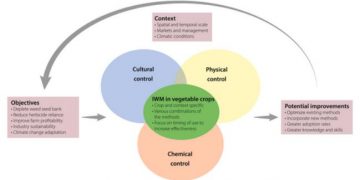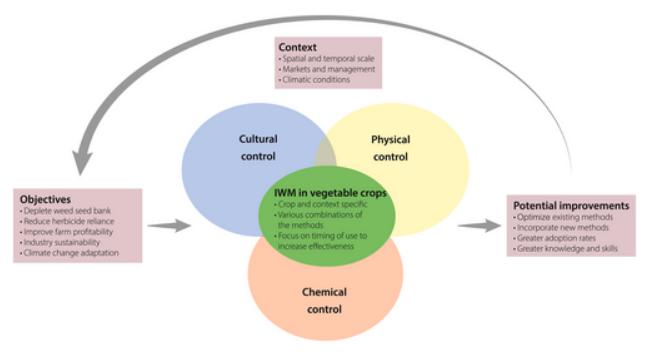Weeds have a significant impact on vegetable production worldwide. These intensive cropping systems feature frequent tillage, fertilization and irrigation, providing ideal growing conditions for crops as well as certain weeds. Integrated weed management (IWM) can reduce reliance on herbicides by encouraging a systems approach to weed management. Using insights from global research and industry literature, we investigated the effectiveness of prevailing weed control methods, and evaluated emerging management practices and technologies for ongoing research and adoption. Weed control relies primarily on a relatively narrow range of herbicides as well as frequent tillage. Herbicides have negative impacts on soil, water and human health, while tillage impacts soil quality and function. Intensive cropping on smaller plots facilitates IWM, relying on multiple strategies including hand weeding, mulches, cover crops and cultural methods (e.g., crop rotations, timing). New herbicide options are suggested as an industry priority but are constrained by the lack of new chemistry and potential herbicide resistance. Refinement and adoption of non-herbicide and emerging precision control methods into farm IWM in vegetables is more likely to be sustainable.
IWM involves using a combination of weed control methods in a strategic way to reduce the burden of weeds (notably, by depleting the weed seed bank) and to reduce herbicide reliance.
hand weeding and tillage may predominate in carrot (Daucus carota subsp. sativus), brassica (Brassica L.), celery (Apium graveolens L.) and lettuce (Lactuca sativa L.) crops, with plastic mulch not used. However in conventional cucurbit crops, plastic mulch is a cornerstone of weed management, supported by tillage, pre- and post-emergent herbicide use and hand weeding to remove occasional weeds growing through the mulch layer. Organic vegetable growers rely on a range of non-herbicide weed control methods, including cover crops, tillage, hand weeding and maximizing crop competitiveness .
Timing is a critical element of IWM—too early and some weeds may re-establish in the crop; too late and weeds may be too large to control effectively. This is well known in terms of individual control methods . However it also applies to implementing IWM, where the temporal scale is greater than the current season and requires the consideration of factors such as crop sequencing based on prevailing weed loads, assessing whether delays due to stale seed beds are worthwhile, minimizing seed production in late-season weeds, and building soil fertility over time to improve crop vigor and health .
Timing the implementation of different weed management methods also impacts on the potential for crop damage . In the case of physical and mechanical weed control, the risk of crop damage increases later in the crop life, as larger crop plants are generally more prone to damage from most weed management activities than smaller crop plants . Application of pre-emergent herbicides may be timed in such a way that crops establish and have a greater capacity to out-compete later weed cohorts . Most techniques are only suitable at certain times in the crop cycle, or for particular management circumstances and personal preferences , hence the need to integrate several techniques effectively to ensure frequent intervention in vegetable crops to suppress weeds using “many little hammers” .
Reference: Coleman, M. J., Kristiansen, P., Sindel, B. M., & Fyfe, C. (2024). Imperatives for integrated weed management in vegetable production: Evaluating research and adoption. Weed Biology and Management, 24(1), 3–14. https://doi.org/10.1111/wbm.12285































